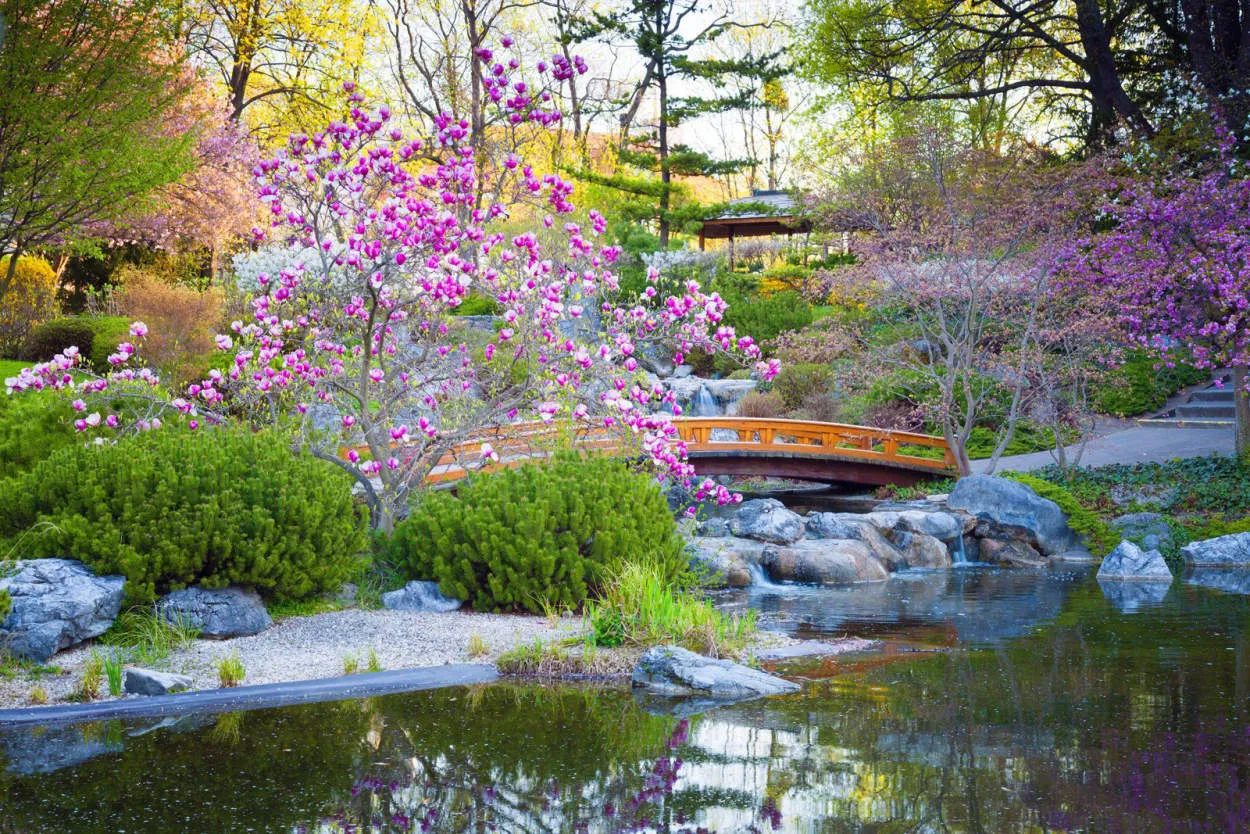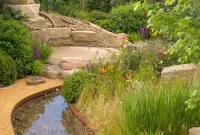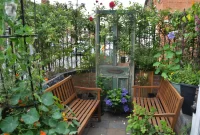Japanese gardens are renowned for their serene beauty and meticulous design. Dating back to ancient times, these gardens are an art form that combines nature, architecture, and spirituality. In this article, we will explore the essence of Japanese garden design and unveil the secrets behind their tranquility.
Principles of Japanese Garden Aesthetics
The art of Japanese garden design is deeply rooted in the principles of aesthetics that have been valued for centuries. These principles guide the creation of tranquil and harmonious outdoor spaces that capture the essence of nature. Here are some key principles of Japanese garden aesthetics:
Simplicity (Kanso)
Japanese gardens reflect a minimalist approach, using few elements to create a serene and uncluttered environment. The simplicity encourages a sense of tranquility and allows for contemplation and reflection.
Naturalness (Shizen)
Japanese gardens aim to mimic the natural landscape. They incorporate elements such as rocks, water features, and plants in a way that appears seamless and organic. The goal is to create a space that feels like a small piece of untouched nature.
Balance (Koko)
The principle of balance is fundamental in Japanese garden design. It involves careful consideration of the placement and arrangement of elements to achieve a sense of equilibrium. This can be achieved through the use of asymmetry, creating a dynamic and harmonious composition.
Harmony (Wa)
Japanese gardens strive to create a harmonious and peaceful atmosphere. This is achieved through the careful selection and arrangement of materials and plants, as well as the incorporation of natural sounds, such as water flowing or wind rustling through trees.
Symbolism (Fukinsei)
Japanese gardens often incorporate symbolic elements that represent deeper meanings. For example, rocks may symbolize mountains, while water features can represent a river or ocean. These symbolic elements add layers of significance and enhance the overall aesthetic experience.
Seasonality (Sakura)
Japanese gardens celebrate the changing seasons. The design and selection of plants are carefully chosen to highlight the beauty of each season. From cherry blossoms in spring to vibrant foliage in autumn, the gardens offer a dynamic and ever-changing landscape throughout the year.
Selecting Plants for a Japanese Garden
When it comes to designing a Japanese garden, selecting the right plants is essential to creating an authentic and serene atmosphere. The art of Japanese garden design aims to blend elements of nature, simplicity, and tranquility to create a harmonious space. Here are some key considerations to keep in mind while choosing plants for your Japanese garden:
1. Embrace Nature’s Beauty
Japanese gardens prioritize the beauty of natural elements. Consider incorporating plants that are native to Japan, such as cherry blossoms, azaleas, bamboo, Japanese maples, and moss. These plants not only provide an authentic touch but also symbolize the seasons, bringing a sense of change and renewal.
2. Focus on Simplicity
Simplicity is a fundamental principle in Japanese garden design. Opt for plants with a clean, minimalist aesthetic. Avoid overly elaborate or colorful flowers and instead choose plants with subtle and calming tones. Japanese gardens often feature evergreen plants like pine trees and ferns, as they maintain their beauty throughout the year.
3. Create Balance and Harmony
Balance and harmony are key aspects of Japanese aesthetic philosophy. Arrange your plants in a way that creates a sense of equilibrium. Group plants in odd numbers, use varying heights, and consider creating a focal point for visual balance. Incorporate elements such as rocks and water to enhance the overall harmony.
4. Pay Attention to Seasons
Seasonality plays a crucial role in Japanese gardens. Select plants that showcase the changing seasons and their unique characteristics. For example, cherry blossoms are beloved for their ephemeral beauty in spring, while maples evoke vibrant hues in autumn. By including plants that highlight seasonal transformations, your garden will offer a captivating experience throughout the year.
5. Reflect on Symbolism
Many plants in Japanese culture hold symbolic meanings. Research the symbolism behind various plants and incorporate those that resonate with you. For example, bamboo represents flexibility and strength, while the lotus flower symbolizes purity and enlightenment. By choosing plants with significance, you can add depth and meaning to your Japanese garden.
Incorporating Zen Elements
Japanese garden design is highly admired for its harmonious blend of nature, spirituality, and artistic expression. To fully appreciate the beauty and tranquility of these gardens, it’s important to understand the key elements of Zen that are incorporated into their design.
Simplicity
Zen gardens exude simplicity, with clean lines and minimalism being the hallmarks of their design. This concept can be seen in the arrangement of carefully placed rocks, pruned trees, and raked gravel or sand patterns. The simplicity allows for a sense of calm and promotes contemplation.
Spatial Awareness
Japanese gardens often make use of a limited space to create a sense of expansiveness. By carefully positioning elements like rocks, trees, and water features, designers create illusions of depth and distance. The deliberate use of negative space promotes a feeling of tranquility and encourages a deep connection with nature.
Natural Materials
The materials used in Japanese garden design emphasize the beauty of nature. Stone, wood, and water are common elements integrated into the landscape. These natural materials maintain the garden’s organic feel and provide a calming contrast to our modern, urbanized world.
Balance and Harmony
Zen philosophy emphasizes the importance of balance and harmony in life, and this principle is translated into Japanese garden design as well. The arrangement of elements in the garden aims to create a harmonious and balanced composition. The equilibrium between yin and yang, light and shadow, and asymmetry and symmetry is carefully considered.
Symbolism
Japanese gardens often incorporate symbolic elements to enhance their meaning and to evoke certain emotions. Symbolism may be expressed through the choice of plants, specific patterns in gravel, or the positioning of rocks. These symbols can represent various concepts like purity, strength, or enlightenment.
By incorporating Zen elements into Japanese garden design, a serene and contemplative space is created. The artistry and attention to detail enable visitors to experience a sense of peace and tranquility as they immerse themselves in the beauty of nature.
Water Features in Japanese Gardens
Japanese gardens are renowned for their calming and serene nature, and one of the key elements that contributes to this is the presence of water features. Water is considered a vital component in these gardens, symbolizing purity, tranquility, and the flow of life. This article will explore some of the popular water features found in traditional Japanese garden design.
Koi Ponds
Koi ponds are a common feature in Japanese gardens, known for their colorful and graceful koi fish. These ponds provide a sense of tranquility and beauty as visitors can watch these elegant creatures swim gracefully through the water. The sound of water flowing in and out of the pond creates a soothing and peaceful atmosphere.
Streams and Waterfalls
Streams and waterfalls are often incorporated into Japanese gardens to mimic the natural flow of rivers and cascades. These water features provide a dynamic element to the garden, as water gently trickles over rocks or rushes down in small waterfalls. The sound of running water adds a refreshing and soothing ambiance to the surroundings.
Tsukubai
A tsukubai is a small stone basin traditionally placed near tea houses or temple entrances. It serves as a water feature for guests to cleanse their hands before entering, symbolizing purification. The design of the tsukubai is often simple yet elegant, with water gently flowing from a bamboo pipe into the basin, creating a peaceful and meditative atmosphere.
Reflecting Pools
Reflecting pools, or “chisen-kaiyu-shiki” in Japanese, are still water features that mirror the surrounding landscape. These pools are often strategically placed in front of important structures such as shrines or teahouses, enhancing their beauty and creating a sense of harmony. The tranquility and stillness of the water create a reflective and contemplative space.
Water features play a crucial role in Japanese garden design, adding a sense of serenity and harmony to the overall composition. From the graceful movements of koi fish in ponds to the gentle flow of streams and the peacefulness of reflecting pools, these water features create a connection with nature and provide a source of relaxation for visitors.
Conclusion
The art of Japanese garden design encompasses a profound understanding of nature and a deep appreciation for simplicity and harmony. With careful arrangement of elements such as rocks, water, plants, and structures, these gardens create a tranquil space that promotes relaxation and reflection. The careful balance of asymmetry, using principles of borrowed scenery and minimalistic design, makes Japanese gardens truly unique and captivating.







